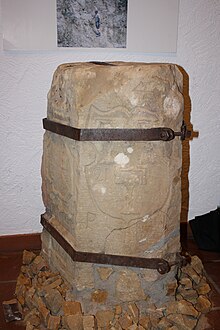Hohebannstein
The High Bannstein even Hohbannstein called, is a historic landmark on the southern part of the beautiful mountain range forming Hohfirst south of Freiburg . Its peculiarity is that there, with the districts of Bollschweil , Ehaben , Kirchhofen (today Ehrenkirchen municipality ), Pfaffenweiler and Wolfenweiler (today Schallstadt municipality ), five municipalities border each other.
The name Hohebannstein is derived from the term Bann for district , which is still used today in the Alemannic-speaking area .
The Hohebannstein is the most prominent of the numerous historical boundary stones in the Hohfirstwald, which mark the borders that run towards the stone. The largest and most splendid are located on the border between Ehaben and Wolfenweiler (Schallstadt) in the forest west of the Hohfirst summit.
Geographical location
The shortest way to get to the Hohebannstein is from the communal road Ehaben - Wittnau . It is located at 410 meters above sea level, around 300 meters east below the Hohfirst summit on a forest path, 100 meters from the former Bollschweil lime mine.
history
The Hohfirst, which is territorially divided by the Hohebannstein, was used in the form of a common land by the surrounding villages until the early 15th century . Population growth, but also an increasingly independent policy of the municipalities towards their landlords, then led to the disappearance of the commons.
The communities now tried to expand their respective districts as far as possible on the mountain. Here, the localities of Pfaffenweiler and Wolfenweiler in particular got into a dispute, in which Ehaben was then also indirectly included, as Pfaffenweiler tried to persuade its landlords to claim rule over the Ebringer district of Talhausen for four generations. If Pfaffenweiler had been successful, this would have allowed complete control over the northwestern Hohfirst at the expense of Wolfenweiler and Ehaben. The lawsuit failed. In 1748 the Hohfirst was divided among the neighboring communities in the demarcation that is still valid today and the Hohebannstein was built.
The process of dividing the Hohfirst testifies to the complicated political situation in the late Middle Ages and early modern times. Territorial disputes not only led the noble landlords among themselves, but also the municipalities subject to them, who, however, needed the support of the landlords to enforce their interests, as only these territories could sue.
layout
The stone has the shape of a pentagon, on each side with a coat of arms of the neighboring communities. The original stone was badly damaged in a forest accident in 1996 and has been in the Pfaffenweiler village museum ever since. A replica has stood at the actual border point since 1997.
Marie Luise Kaschnitz describes in her Bollschweil book from 1966 (see literature) the "Hohen Bannstein" as one
“Old boundary stone with five coats of arms, the grape-bearing bears from St. Gallen , the three goblets from Staufen , the bear paws of the Schnaevelins , the coat of arms of Lazarus von Schwendi , the coat of arms of the crown
where one wonders what was once a Thingplatz , a crucifix, a gallows, or at least something that would have on which all communities share to which they long stretched narrow forest tongues. "
literature
- Clausdieter Schott , Edmund Weeger (Hrsg.): Ehaben, rule and community . Volume 1. Rombach-Verlag, Freiburg, ISBN 3-9802758-0-9
- Helge Körner (Hrsg.): The Schönberg - natural and cultural history of a Black Forest foothill . Lavori-Verlag, Freiburg 2006, ISBN 3-935737-53-X , 472 pages, 48 color plates and 200 b / w illustrations.
- Marie Luise Kaschnitz : Description of a village. Suhrkamp Verlag, Frankfurt am Main 1966.
Coordinates: 47 ° 56 ′ 9 ″ N , 7 ° 46 ′ 51 ″ E

